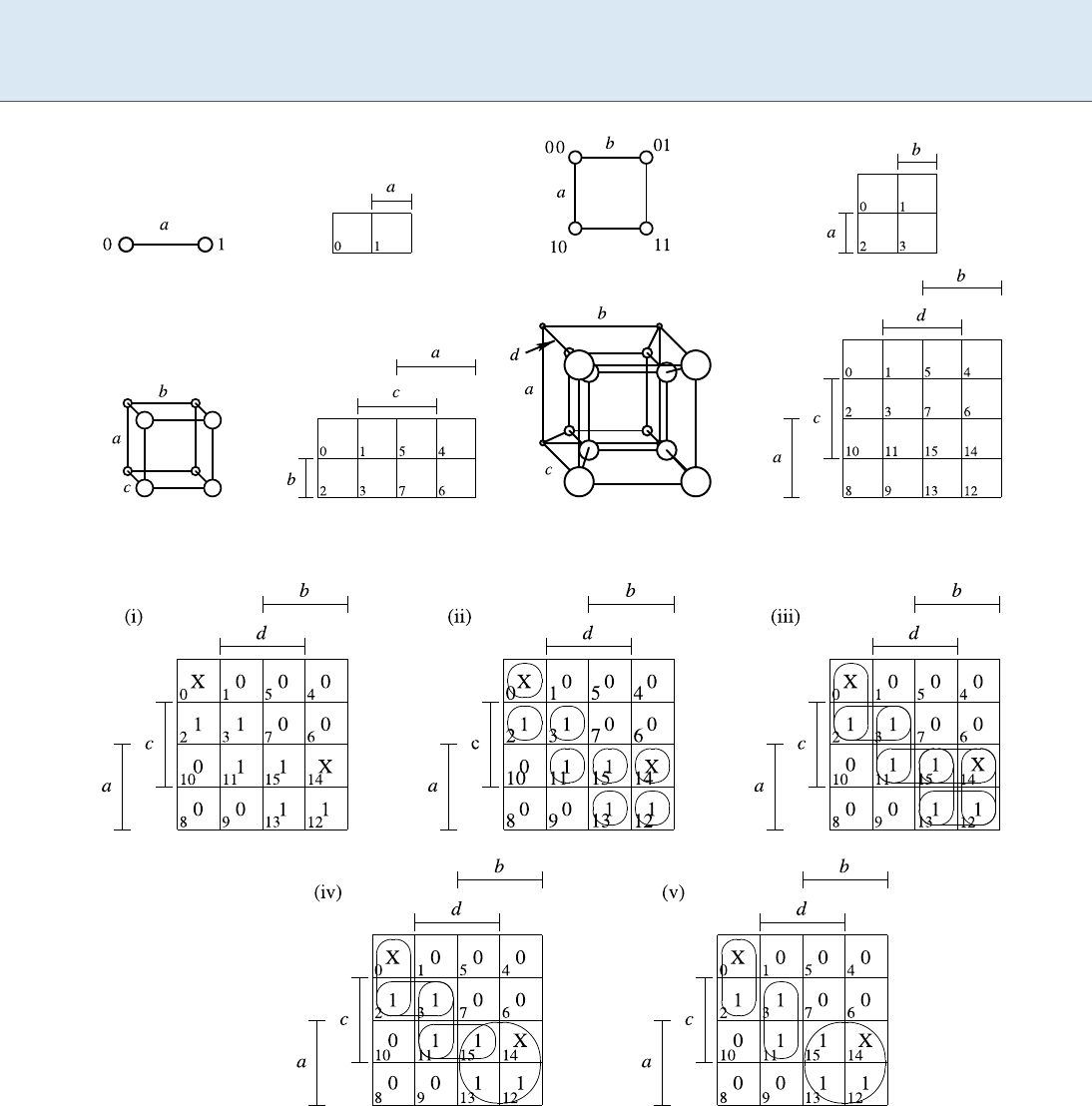Kao M.-Y. (ed.) Encyclopedia of Algorithms
Подождите немного. Документ загружается.


988 T Two-Interval Pattern Problems
Two-Interval Pattern Problems, Table 2
Performance ratios for hard instances of the 2-interval-pattern problem. LP stands for Linear Programming and N/A stands for Not
Applicable
Model R
Interval ground set I(D)
Unlimited Balanced Unit Disjoint
f<; @;Gg 4LP[1] 4
O(n lg n)[7]
2+
O(n
2
+ n
O(log 1/)
)[13]
N/A
f@;Gg 4LP[7] 4
O(n
2
lg n)[7]
2+
O(n
2
+ n
O(log 1/)
)[13]
N/A
f<;Gg 1+1/ O(n
2+3
); 2[14]
Open Problems
A number of problems related to the 2-interval-pattern
problem remain open. First, improving the approxima-
tion ratios for the various flavors of the 2-interval-pattern
problem is of particular importance. For example, the exis-
tence of a fast approximation algorithm with good perfor-
mance guarantee for the 2-interval-pattern problem for
model
R = f<; @;Gg remains an apparently challenging
open problem. A related open research area is concerned
with balanced-interval ground sets. In particular, no ev-
idence has shown yet that the 2-interval-pattern prob-
lem becomes easier to approximate for balanced-interval
ground sets. This question is of special importance in the
context of RNA structures where most 2-intervals are bal-
anced.
A number of important question are still open for
model
R = f<;Gg. First, it is still unknown whether the
2-interval-pattern problem for disjoint-interval ground
sets and model
R = f<;Gg is polynomial-time-solvable.
Observe that this problem trivially reduces to the fol-
lowing graph problem: Given a graph G =(V; E)with
V = f1; 2;:::;ng, find a maximum cardinality matching
M E such that for any two distinct edges fi; jg and
fk; lg of
M, i < j, k < l and i < k,eitherj < k or j < l.
Another open question concerns the approximation of the
2-interval-pattern problem for balanced interval ground
set. Is this special case better approximable than the gen-
eral case?
A last direction of research is concerned with the pa-
rameterized complexity of the 2-interval-pattern prob-
lem. For example, it is not known whether the 2-interval-
pattern problem for models
R = f<; @;Gg, R = f@;Gg or
R = f<;Gg is fixed-parameter-tractable when parameter-
ized by the size of the solution. Also, investigating the pa-
rameterized complexity for parameters such as the max-
imum number of pairwise crossing intervals in the input
set or the treewidth of the corresponding intersection 2-in-
terval graph, which are expected to be relatively small for
most practical applications, is of particular interest.
Cross References
RNA Secondary Structure Prediction Including
Pseudoknots
RNA Secondary Structure Prediction by Minimum
Free Energy
Recommended Reading
1. Bar-Yehuda, R., Halldorsson, M., Naor, J., Shachnai, H., Shapira,
I.: Scheduling split intervals. In: Proc. 13th Annual ACM-SIAM
Symposium on Discrete Algorithms (SODA), 2002, pp. 732–741
2. Billoud, B., Kontic, M., Viari, A.: Palingol a declarative program-
ming language to describe nucleic acids’ secondary structures
and to scan sequence database. Nucleic. Acids. Res. 24, 1395–
1403 (1996)
3. Blin, G., Fertin, G., Vialette, S.: Extracting 2-intervals subsets
from 2-interval sets. Theor. Comput. Sci. 385(1–3), 241–263
(2007)
4. Blin, G., Fertin, G., Vialette, S.: New results for the 2-interval pat-
tern problem. In: Proc. 15th Annual Symposium on Combina-
torial Pattern Matching (CPM). Lecture Notes in Computer Sci-
ence, vol. 3109. Springer, Berlin (2004)
5. Butman, A., Hermelin, D., Lewenstein, M., Rawitz, D.: Optimiza-
tion problems in multiple-interval graphs. In: Proc. 9th Annual
ACM-SIAM Symposium on Discrete Algorithms (SODA), ACM-
SIAM, 2007, pp. 268–277
6. Chen, J.-H., Le, S.-Y., Maize, J.: Prediction of common secondary
structures of RNAs: a genetic algorithm approach. Nucleic.
Acids. Res. 28, 991–999 (2000)
7. Crochemore,M.,Hermelin,D.,Landau,G.,Rawitz,D.,Vialette,
S.: Approximating the 2-interval pattern problem, Theoretical
Computer Science (special issue for Alberto Apostolico) (2008)
8. Erdong, C., Linji, Y., Hao, Y.: Improved algorithms for 2-interval
pattern problem. J. Combin. Optim. 13(3), 263–275 (2007)
9. Halldorsson, M., Karlsson, R.: Strip graphs: Recognition and
scheduling. In: Proc. 32nd International Workshop on Graph-
Theoretic Concepts in Computer Science (WG). Lecture Notes
in Computer Science, vol. 4271, pp. 137–146. Springer, Berlin
(2006)
10. Jiang, M.: A 2-approximation for the preceding-and-crossing
structured 2-interval pattern problem, J. Combin. Optim. 13,
217–221 (2007)
11. Jiang, M.: Improved approximation algorithms for predicting
RNA secondary structures with arbitrary pseudoknots. In: Proc.
3rd International Conference on Algorithmic Aspects in Infor-

Two-Level Boolean Minimization T 989
mation and Management (AAIM), Portland, OR, USA, Lecture
Notes in Computer Science, vol. 4508, pp. 399–410. Springer
(2007)
12. Jiang, M.: A PTAS for the weighted 2-interval pattern problem
over the preceding-and-crossing model. In: Y.X. A.W.M. Dress,
B. Zhu (eds.) Proc. 1st Annual International Conference on
Combinatorial Optimization and Applications (COCOA), Xi’an,
China, Lecture Notes in Computer Science, vol. 4616, pp. 378–
387. Springer (2007)
13. Joseph, D., Meidanis, J., Tiwari, P.: Determining DNA sequence
similarity using maximum independent set algorithms for in-
terval graphs. In: Proc. 3rd Scandinavian Workshop on Al-
gorithm Theory (SWAT). Lecture Notes in Computer Science,
pp. 326–337. Springer, Berlin (1992)
14. Lyngsø, R., Pedersen, C.: RNA pseudoknot prediction in energy-
based models. J. Comput. Biol. 7, 409–427 (2000)
15. Micali,S.,Vazirani,V..AnO
sqrtjVjjEj
algorithm for finding
maximum matching in general graphs. In: Proc. 21st Annual
Symposium on Foundation of Computer Science (FOCS), IEEE,
1980, pp. 17–27
16. Nussinov,R.,Pieczenik,G.,Griggs,J.,Kleitman,D.:Algorithms
for loop matchings. SIAM J. Appl. Math. 35, 68–82 (1978)
17. Ren, J., Rastegart, B., Condon, A., Hoos, H.: HotKnots: Heuristic
prediction of rna secondary structure including pseudoknots.
RNA 11, 1194–1504 (2005)
18. Rivas, E., Eddy, S.: A dynamic programming algorithm for RNA
structure prediction including pseudoknots. J. Mol. Biol. 285,
2053–2068 (1999)
19. Ruan, J., Stormo, G., Zhang, W.: An iterated loop matching ap-
proach to the prediction of RNA secondary structures with
pseudoknots. Bioinformatics 20, 58–66 (2004)
20. Vialette, S.: On the computational complexity of 2-interval pat-
tern matching. Theor. Comput. Sci. 312, 223–249 (2004)
21. Zhao, J., Malmberg, R., Cai, L.: Rapid ab initio rna folding includ-
ing pseudoknots via graph tree decomposition. In: Proc. Work-
shop on Algorithms in Bioinformatics. Lecture Notes in Com-
puter Science, vol. 4175, pp. 262–273. Springer, Berlin (2006)
Two-Level Boolean Minimization
1956; McCluskey
ROBERT DICK
Department Electrical Engineering and Computer
Systems, Northwestern University, Evanston, IL, USA
Keywords and Synonyms
Logic minimization; Quine–McCluskey algorithm; Tabu-
lar method
Problem Definition
Summary
Find a minimal sum-of-products expression for a Boolean
function.
Two-Level Boolean Minimization, Table 1
Equivalent representations with different implementation com-
plexities
Expression Meaning in english Boolean logic
identity
a ^b _a ^b not a and not b or not a and b
Distributivity
Complements
Boundedness
a ^
b _b
not a and either not b or b
a ^True not a and True
a not a
Extended Definition
Consider a Boolean algebra with two elements: False or
True. A Boolean function f (y
1
; y
2
; ; y
n
)ofn Boolean
input variables specifies an output value for each combi-
nation of input variable values. It is possible to represent
the same function with a number of different expressions.
For example, the first and last expressions in Table 1 corre-
spond to this function. Assuming access to complemented
input variables, straight-forward implementations of these
expressions would require two and gates and an or gate for
a ^ b _ a ^ b and only a wire for a. Although the imple-
mentation efficiency depends on target technology, in gen-
eral terser expressions enable greater efficiency. Boolean
minimization is the task of deriving the tersest expression
for a function. Elegant and optimal algorithms exist for
solving the variant of this problem in which the expression
is limited to two levels, i. e., a layer of and gates followed
by a single or gate or a layer of or gates followed by a single
and gate.
Key Results
This survey will start by introducing the Karnaugh Map
visualization technique, which will be used to assist in
the subsequent explanation of the Quine–McCluskey algo-
rithm for two-level Boolean minimization. This algorithm
is optimal for its constrained problem variant. It is one of
the fundamental algorithms in the field of computer-aided
design and forms the basis or inspiration for many solu-
tions to more general variants of the Boolean minimiza-
tion problem.
Karnaugh Maps
Karnaugh Maps [4] provide a method of visualizing adja-
cency in Boolean space. A Karnaugh Map is a projection of
an n-dimensional hypercube onto two-dimensional sur-
face such that adjacent points in the hypercube remain ad-
jacent in the two-dimensional projection. Figure 1 illus-
trates Karnaugh Maps of 1, 2, 3, and 4 variables: a, b, c,
and d.

990 T Two-Level Boolean Minimization
Two-Level Boolean Minimization, Figure 1
Boolean function spaces from one to four dimensions and their corresponding Karnaugh Maps
Two-Level Boolean Minimization, Figure 2
(i) Karnaugh Map of function f (a; b; c; d), (ii) elementary implicants, (iii) second-order implicants, (iv) prime implicants, and (v) a min-
imal cover
A literal is a single appearance of a complemented or
uncomplemented input variable in a Boolean expression.
A product term or implicant is the Boolean product, or
and, of one or more literals. Every implicant corresponds
to a repeated balanced bisection of Boolean space, or of the
corresponding Karnaugh Map, i. e., an implicant is a rect-
angle in a Karnaugh Map with width m and height n where
m =2
j
and n =2
k
for arbitrary non-negative integers j
and k,e.g,theovalsinFig.2(ii–v). An elementary impli-
cant is an implicant in which, for each variable of the cor-

Two-Level Boolean Minimization T 991
responding function, the variable or its complement ap-
pears, e. g., the circles in Fig. 2(ii). Implicant Acoversim-
plicant B if every elementary implicant in B is also in A.
Prime implicants are implicants that are not covered by
any other implicants, e. g., the ovals and circle in Fig. 2(iv).
It is unnecessary to consider anything but prime impli-
cants when seeking a minimal function representation be-
cause, if a non-prime implicants could be used to cover
some set of elementary implicants, there is guaranteed to
exist a prime implicant that covers those elementaryimpli-
cants and contains fewer literals. One can draw the largest
implicants covering each elementary implicant and cover-
ing no positions for which the function is False,thereby
using Karnaugh Maps to identify prime implicants. One
can then manually seek a compact subset of prime impli-
cants covering all elementary implicants in the function.
This Karnaugh Map based approach is effective for
functions with few inputs, i. e., those with low dimen-
sionality. However, representing and manipulating Kar-
naugh Maps for functions of many variables is challenging.
Moreover, the Karnaugh Map method provides no clear
set of rules to follow when selecting a minimal subset of
prime implicants to implement a function.
The Quine–McCluskey Algorithm
The Quine–McCluskey algorithm provides a formal, op-
timal way of solving the two-level Boolean minimiza-
tion problem. W. V. Quine laid the essential theoret-
ical groundwork for optimal two-level logic minimiza-
tion [7,8]. However, E. J. McCluskey first proposed a pre-
cise algorithm to fully automate the process [6].
The Quine–McCluskey method has two phases:
(1) produce all prime implicants and (2) select a minimal
subset of prime implicants covering the function. In the
first phase, the elementary implicants of a function are it-
eratively combined to produce implicants with fewer lit-
erals. Eventually, all prime implicants are thus produced.
In the second phase, a minimal subset of prime implicants
covering the on-set elementary implicants is selected using
unate covering.
The Quine–McCluskey method may be illustrated us-
ing an example. Consider the function indicated by the
Karnaugh Map in Fig. 2(i) and the truth table in Table 2.
For each combination of Boolean input variable values, the
function f (a; b; c; d) is required to output a 0 (False), a 1
(True), or has no requirement. The lack of a requirement
is indicated with an X, or don’t-care symbol.
Expanding implicants as much as possible will ulti-
mately produce the prime implicants. To do this, combine
on-set and don’t-care elementary implicants using the re-
Two-Level Boolean Minimization, Table 2
Truth table of function f(a; b; c; d)
Elementary
implicant
(a; b; c; d)
Function
value
(a; b; c; d)
Elementary
implicant
Function
value
0000 X 1000 0
0001 0 1001 0
0010 1 1010 0
0011 1 1011 1
0100 0 1100 1
0101 0 1101 1
0110 0 1110 X
0111 0 1111 1
Two-Level Boolean Minimization, Table 3
Identifying prime implicants
Number
of ones
Elementary implicant
(a; b; c; d)
Second-order
implicant
Third-order
implicant
0 0000 X 00X0
1 0010 X 001X
2
0011 X
1100 X
X011
110X X
11X0 X
11XX
3
1011 X
1101 X
1110 X
1X11
11X1 X
111X X
4 1111 X
duction theorem (ab _ ab = b)showninTable1.Theel-
ementary implicants are circled in Fig. 2(ii) and listed in
the second column of Table 3.Inthistable,0sindicate
complemented variables and 1s indicate uncomplemented
variables, e. g., 0010 corresponds to
abcd. It is necessary
to determine all possible combinations of implicants. It is
impossible to combine non-adjacent implicants, i. e., those
that differ in more than one variable. Therefore, it is not
necessary to consider combining any pair of implicants
with a number of uncomplemented variables differing by
any value other than 1. This fact can be exploited by or-
ganizing the implicants based on the number of ones they
contain, as indicated by the first column in Table 3.All
possible combinations of implicants in adjacent subsets
are considered. For example, consider combining 0010
with 0011, which results in 001X or
abc, and also consider
combining 0010 with 1100, which is impossible due to dif-
ferences in more than one variable. Whenever an impli-
cant is successfully merged, it is marked. These marked
implicants are clearly not prime implicants because the
implicants they produced cover them and contain fewer
literals. Note that marked implicants should still be used
for subsequent combinations. The merged implicants in

992 T Two-Level Boolean Minimization
Two-Level Boolean Minimization, Table 4
Solving unate covering problem to select minimal cover
Requirements
(elementary implicants)
Resources (prime implicants)
00X0 001X X011 1X11 11XX
0010 X X
0011 X X
1011 X X
1100 X
1101 X
1111 X X
the third column of Table 3 correspond to those depicted
in Fig. 2(iii).
After all combinations of elementary implicants have
been considered, and successful combinations listed in the
third column, this process is repeated on the second-order
merged implicants in the third column, producing the
implicants in the fourth column. Implicants that contain
don’t-care marks in different locations may not be com-
bined. This process is repeated until a column yielding no
combinations is arrived at. The unmarked implicants in
Table 3 aretheprimeimplicants,whichcorrespondtothe
implicants depicted in Fig. 2(iv).
After a function’s prime implicants have been identi-
fied, it is necessary to select a minimal subset that cov-
ers the function. The problem can be formulated as unate
covering.AsshowninTable4, label each column of a ta-
blewithaprimeimplicant;theseareresourcesthatmay
be used to fulfill the requirements of the function. Label
each row with an elementary implicant from the on-set;
these rows correspond to requirements. Do not add rows
for don’t-cares. Don’t-cares impose no requirements, al-
though they were useful in simplifying prime implicants.
Mark each row–column intersection for which the ele-
mentary implicant corresponding to the row is covered by
the prime implicant corresponding to the column. If a col-
umn is selected, all the rows for which the column con-
tains marks are covered, i. e., those requirements are satis-
fied. The goal is to cover all rows with a minimal-cost sub-
set of columns. McCluskey defined minimal cost as having
a minimal number of prime implicants, with ties broken
by selecting the prime implicants containing the fewest
literals. The most appropriate cost function depends on
the implementation technology. One can also use a sim-
ilar formulation with other cost functions, e. g., minimize
the total number of literals by labeling each column with
a cost corresponding to the number of literals in the cor-
responding prime implicant.
One can use a number of heuristics to accelerate so-
lution of the unate covering problem, e. g., neglect rows
that have a superset of the marks of any other row, for
they will be implicitly covered and neglect columns that
have a subset of the marks of any other column if their
costs are as high, for the other column is at least as use-
ful. One can easily select columns as long as there exists
a row with only one mark because the marked column is
required for a valid solution. However, there exist prob-
lem instances in which each row contains multiple marks.
In the worst case, the best existing algorithms are required
to make tentative decisions, determine the consequences,
then backtrack and evaluate alternative decisions.
The unate covering problem appears in many applica-
tions. It is
NP-complete [5], even for the instances arising
during two-level minimization [9]. Its use in the Quine–
McCluskey method predates its categorization as an
NP-
complete problem by 16 years. A detailed treatment of this
problem would go well beyond the scope of this entry.
However, Gimpel [3]aswellasCoudertandMadre[2]
provide good starting points for further reading.
Some families of logic functions have optimal two-
level representations that grow in size exponentially in the
number of inputs, but have more compact multi-level im-
plementations. These families are frequently encountered
in arithmetic, e. g., a function indicating whether the num-
ber of on inputs is odd. Efficient implementation of such
functions requires manual design or multilevel minimiza-
tion [1].
Applications
Digital computers are composed of precisely two things:
(1) implementations of Boolean logic functions and
(2) memory elements. The Quine–McCluskey method is
used to permit efficient implementation of Boolean logic
functions in a wide range of digital logic devices, includ-
ing computers. The Quine–McCluskey method served as
a starting point or inspiration for most currently-used
logic minimization algorithms. Its direct use is contra-
dicted when functions are not amenable to efficient two-
level implementation, e. g., many arithmetic functions.
Cross References
Local Approximation of Covering and Packing
Problems
Recommended Reading
1. Brayton, R.K., Hachtel, G.D., Sangiovanni-Vincentelli, A.L.: Multi-
level logic synthesis. Proc. IEEE 78(2), 264–300 (1990)
2. Coudert, O., Madre, J.C.: New ideas for solving covering prob-
lems. In: Proc. Design Automation Conf., 1995, pp. 641–646

Two-Player Nash T 993
3. Gimpel, J.F.: A reduction technique for prime implicant tables.
IEEE Trans. Electron. Comput. 14(4), 535–541 (1965)
4. Karnaugh, M.: The map method for synthesis of combina-
tional logic circuits. Trans. AIEE, Commun. Electron. 72, 593–599
(1953)
5. Karp, R.M.: Reducibility among combinatorial problems. In:
Miller, R.E., Thatcher, J.W. (eds.) Complexity of Computer Com-
putations, pp. 85–103. Plenum Press, New York (1972)
6. McCluskey, E.J.: Minimization of Boolean functions. Bell Syst.
Tech. J. 35(6), 1417–1444 (1956)
7. Quine, W.V.: The problem of simplyfying truth functions. Am.
Math. Mon. 59(8), 521–531 (1952)
8. Quine, W.V.: A way to simplify truth functions. Am. Math. Mon.
62(9), 627–631 (1955)
9. Umans, C., Villa, T., Sangiovanni-Vincentelli, A.L.: Complexity of
two-level logic minimization. IEEE Trans. Comput.-Aided Des. In-
tegr. Circuits Syst. 25(7), 1230–1246 (2006)
Two-Person Game
Complexity of Bimatrix Nash Equilibria
Two-Player Game
Complexity of Bimatrix Nash Equilibria
Two-Player Nash
Complexity of Bimatrix Nash Equilibria

Undirected Feedback Vertex Set U 995
U
Undirected Feedback Vertex Set
2005; Dehne, F ellows, Langston, Rosamond,
Stevens
2005; Guo, Gramm, Hüffner, Niedermeier,
Wernicke
JIONG GUO
1
Department of Mathematics and Computer Science,
University of Jena, Jena, Germany
Keywords and Synonyms
Odd cycle transversal
Problem Definition
The U
NDIRECTED FEEDBACK VERTEX SET (UFVS) prob-
lem is defined as follows:
Input:AnundirectedgraphG =(V; E)andaninte-
ger k 0.
Task:Findafeedback vertex set F V with jFjk
such that each cycle in G contains at least one vertex
from F. (The removal of all vertices in F from G re-
sults in a forest.)
Karp [11] showed that UFVS is NP-complete. Lund
and Yannakakis [12] proved that there exists some con-
stant >0 such that it is NP-hard to approximate the op-
timization version of UFVS to within a factor of 1 + .
The best-known polynomial-time approximation algo-
rithm for UFVS has a factor of 2 [1,4]. There is a simple
and elegant randomized algorithm due to Becker et al. [3]
which solves UFVS in O(c4
k
kn)timeonann-vertex and
m-edge graph by finding a feedback vertexsetof size k with
probability at least 1 (1 4
k
)
c4
k
for an arbitrary con-
stant c. An exact algorithm for UFVS with a running time
1
Supported by the Deutsche Forschungsgemeinschaft, Emmy
Noether research group PIAF (fixed-parameter algorithms), NI 369/4
of O(1.7548
n
) was recently found by Fomin et al. [9]. In
the context of parameterized complexity [8,13], Bodlaen-
der [5] and Downey and Fellows [7] were the first to show
that the problem is fixed-parameter tractable, i. e., that the
combinatorial explosion when solving it can be confined
to the parameter k. The currently best fixed-parameter al-
gorithm for UFVS runs in O(c
k
mn) for a constant c [6,10]
(see [6] for the so far best running time analysis leading to
aconstantc =10:567). This algorithm is the subject of this
entry.
Key Results
The O(c
k
mn)-time algorithm for the UNDIRECTED FEED-
BACK VERTEX SET is based on the so-called “iterative
compression” technique, which was introduced by Reed et
al. [14]. The central observation of this technique is quite
simple but fruitful: To derive a fixed-parameter algorithm
for a minimization problem, it suffices to give a fixed-
parameter “compression routine” that, given a size-(k +1)
solution, either proves that there is no size-k solution or
constructs one. Starting with a trivial instance and iter-
atively applying this compression routine a linear num-
ber of rounds to larger instances, one obtains a fixed-
parameter algorithm of the problem. The main challenge
of applying this technique to UFVS lies in showing that
there is a fixed-parameter compression routine.
The compression routine from [6,10] works as follows:
1 Consider all possible partitions (X, Y)ofthesize-
(k + 1) feedback vertex set F with jXjk under the
assumption that set X is entirely contained in the new
size-k feedback vertex set F
0
and Y \ F
0
= ;
2 For each partition (X, Y), if the vertices in Y induce cy-
cles, then answer “no” for this partition; otherwise, re-
move the vertices in X. Moreover, apply the following
data reduction rules to the remaining graph:
Remove degree-1 vertices.
If there is a degree-2 vertex v with two neighbors v
1
and v
2
,wherev
1
… Y or v
2
… Y,thenremovev and
connect v
1
and v
2
. If this creates two parallel edges

996 U Unified Energy-Efficient Unicast and Broadcast Topology Control
between v
1
and v
2
, then remove the vertex of v
1
and v
2
that is not in Y and add it to any feedback
vertex set for the reduced instance.
Finally, exhaustively examine every vertex set S with
size at most k jXj of the reduced graph as to
whether S can be added to X to form a feedback ver-
tex set of the input graph. If there is one such vertex set,
then output it together with X as the new size-k feed-
back vertex set.
The correctness of the compression routine follows from
its brute-force nature and the easy to prove correctness of
the two data reduction rules. The more involved part is to
show that the compression routine runs in O(c
k
m)time:
There are 2
k
+1 partitions of F into the above sets (X, Y)
and one can show that, for each partition, the reduced
graph after performing the data reduction rules has at
most dk vertices for a constant d;otherwise,thereisno
size-k feedback vertex set for this partition. This then gives
the O(c
k
m)-running time. For more details on the proof
of the dk-size bound see [6,10].
Given as input a graph G with vertex set fv
1
;:::;v
n
g,
the fixed-parameter algorithm from [6,10] solves UFVS
by iteratively considering the subgraphs G
i
:= G[fv
1
;:::;
v
i
g]. For i = 1, the optimal feedback vertex set is empty.
For i > 1, assume that an optimal feedback vertex set X
i
for G
i
is known. Obviously, X
i
[fv
i+1
g is a solution set
for G
i+1
. Using the compression routine, the algorithm
can in O(c
k
m) time either determine that X
i
[fv
i+1
g is
an optimal feedback vertex set for G
i+1
,or,ifnot,com-
pute an optimal feedback vertex set for G
i+1
.Fori = n,we
thus have computed an optimal feedback vertex set for G
in O(c
k
mn)time.
Theorem 1 U
NDIRECTED FEEDBACK VERTEX SET can
be solved in O(c
k
mn) time for a constant c.
Applications
The U
NDIRECTED FEEDBACK VERTEX SET is of funda-
mental importance in combinatorial optimization. One
typical application, for example, appears in the context of
combinatorial circuit design [1]. For applications in the ar-
eas of constraint satisfaction problems and Bayesian infer-
ence, see Bar-Yehuda et al. [2].
Open Problems
It is open to explore the practical performance of the de-
scribed algorithm. Another research direction is to im-
prove the running time bound given in Theorem 1. Fi-
nally, it remains a long-standing open problem whether
the F
EEDBACK VERTEX SET on directed graphs is fixed-
parameter tractable. The answer to this question would
represent a significant breakthrough in the field.
Recommended Reading
1. Bafna, V., Berman, P., Fujito, T.: A 2-approximation algorithm
for the undirected feedback vertex set problem. SIAM J. Dis-
cret. Math. 3(2), 289–297 (1999)
2. Bar-Yehuda, R., Geiger, D., Naor, J., Roth, R.M.: Approximation
algorithms for the feedback vertex set problem with applica-
tions to constraint satisfaction and Bayesian inference. SIAM
J. Comput. 27(4), 942–959 (1998)
3. Becker, A., Bar-Yehuda, R., Geiger, D.: Randomized algorithms
for the Loop Cutset problem. J. Artif. Intell. Res. 12, 219–234
(2000)
4. Becker, A., Geiger, D.: Approximation algorithms for the Loop
Cutset problem. In: Proc. 10th Conference on Uncertainty in Ar-
tificial Intelligence, pp. 60–68. Morgan Kaufman, San Fransisco
(1994)
5. Bodlaender, H.L.: On disjoint cycles. Int. J. Found. Comp. Sci.
5(1), 59–68 (1994)
6. Dehne, F., Fellows, M.R., Langston, M.A., Rosamond, F.,
Stevens, K.: An O(2
O(k)
n
3
) FPT algorithm for the undirected
feedback vertex set problem. In: Proc. 11th COCOON. LNCS,
vol. 3595, pp. 859–869. Springer, Berlin (2005). Long version to
appear in: J. Discret. Algorithms
7. Downey, R.G., Fellows, M.R.: Fixed-parameter tractability and
completeness. Congres. Numerant. 87, 161–187 (1992)
8. Downey, R.G., Fellows, M.R.: Parameterized Complexity.
Springer, Heidelberg (1999)
9. Fomin, F.V., Gaspers, S., Pyatkin, A.V.: Finding a minimum feed-
back vertex set in time O(1.7548
n
). In: Proc. 2th IWPEC. LNCS,
vol. 4196, pp. 184–191. Springer, Berlin (2006)
10. Guo, J., Gramm, J., Hüffner, F., Niedermeier, R., Wernicke, S.:
Compression-based fixed-parameter algorithms for Feedback
Vertex Set and Edge Bipartization. J. Comp. Syst. Sci. 72(8),
1386–1396 (2006)
11. Karp, R.: Reducibility among combinatorial problems. In:
Miller, R., Thatcher, J. (eds.) Complexity of Computer Compu-
tations, pp. 85–103. Plenum Press, New York (1972)
12. Lund, C., Yannakakis, M.: The approximation of maximum sub-
graph problems. In: Proc. 20th ICALP. LNCS, vol. 700, pp. 40–51.
Springer, Berlin (1993)
13. Niedermeier, R.: Invitation to Fixed-Parameter Algorithms. Ox-
ford University Press, Oxford (2006)
14. Reed, B., Smith, K., Vetta, A.: Finding odd cycle transversals.
Oper. Res. Lett. 32(4), 299–301 (2004)
Unified Energy-Efficient Unicast
and Broadcast Topology Control
Degree-Bounded Planar Spanner with Low Weight
University Admissions P roblem
Hospitals/Residents Problem

Utilitarian Mechanism Design for Single-Minded Agents U 997
Using Visualization in the Empirical
Assessment of Algorithms
Visualization Techniques for Algorithm Engineering
Utilitarian Mechanism Design
for Single-Minded Agents
2005; Briest, Krysta, Vöcking
PIOTR KRYSTA
1
,BERTHOLD VÖCKING
2
1
Department of Computer Science, University of
Liverpool, Liverpool, UK
2
Department of Computer Science, RWTH Aachen
University, Aachen, Germany
Keywords and Synonyms
Forward (combinatorial, multi-unit) auction
Problem Definition
This problem deals with the design of efficiently com-
putable incentive compatible, or truthful, mechanisms for
combinatorial optimization problems with selfish one-
parameter agents and a single seller. The focus is on ap-
proximation algorithms for NP-hard mechanism design
problems. These algorithms need to satisfy certain mono-
tonicity properties to ensure truthfulness.
A one parameter agent is an agent who as her private
data has some resource as well as a valuation,i.e.,themax-
imum amount of money she is willing to pay for this re-
source. Sometimes, however, the resource is assumed to
be known to the mechanism. The scenario where a sin-
gle seller offers these resources to the agents is primarily
considered. Typically, the seller aims at maximizing the
social welfare or her revenue. The work by Briest, Krysta
and Vöcking [6] will mostly be considered, but also other
existing models and results will be surveyed.
Utilitarian Mechanism Design
A famous example of mechanism design problems is given
by combinatorial auctions (CAs), in which a single seller,
auctioneer, wants to sell a collection of goods to poten-
tial buyers. A wider class of problems is encompassed
by a utilitarian mechanism design (maximization) prob-
lem ˘ defined by a finite set of objects
A, a set of feasi-
ble outputs O
˘
A
n
and a set of n agents. Each agent
declares a set of objects S
i
A and a valuation func-
tion v
i
: P(A) A
n
! R by which she values all possible
outputs. Given a vector S =(S
1
;:::;S
n
)ofdeclarations
one is interested in output o
2 O
˘
maximizing the social
welfare,i.e.,o
2 argmax
o2O
˘
P
n
i=1
v
i
(S
i
; o). In CAs, an
object a corresponds to a subset of goods. Each agent de-
clares all the subsets she is interested in and the prices she
would be willing to pay. An output specifies the sets to be
allocated to the agents.
Here, a limited type of agents called single-minded
is considered, introduced by Lehmann et al. [10]. Let
R
A
2
be a reflexive and transitive relation on A,
such that there exists a special object ¿ 2
A with ¿ a
for any a 2
A to model the situation in which some
agent does not contribute to the solution at all. For
a; b 2
A (a; b) 2 R
will be denoted by a b.The
single-minded agent i declares a single object a
i
and is fully
defined by her type (a
i
; v
i
), with a
i
2 A and v
i
> 0. The
valuation function introduced earlier reduces to
v
i
(a
i
; o)=
(
v
i
; if a
i
o
i
0 ; else :
Agent i is called known if object a
i
is known to the
mechanism [11]. Here, mostly unknown agents will be
considered. Intuitively, each a
i
corresponds to an ob-
ject agent i offers to contribute to the solution, v
i
de-
scribes her valuation of any output o that indeed selects
a
i
.InCAs,relationR
is set inclusion: an agent inter-
ested in set S will is also satisfied by S
0
with S S
0
.
For ease of notation let (a; v)=((a
1
; v
1
);:::;(a
n
; v
n
)),
(a
i
; v
i
)=((a
1
; v
1
);:::;(a
i1
; v
i1
); (a
i+1
; v
i+1
);:::;
(a
n
; v
n
)) and ((a
i
; v
i
); (a
i
; v
i
)) = (a; v).
Mechanism
A mechanism M =(A; p) consists of an algorithm A
computing a solution A(a; v) 2 O
˘
and an n-tuple
p(a; v)=(p
1
(a; v);:::;p
n
(a; v)) 2 R
n
+
of payments col-
lected from the agents. If a
i
A(a; v)
i
,agenti is se-
lected,andletS(A(a; v)) = fija
i
A(a; v)
i
g be the set
of selected agents. Agent i’s type is her private knowl-
edge. Thus, the types declared by agents may not
match their true types. To reflect this, let (a
i
; v
i
)re-
fer to agent i’s true type and (a
i
; v
i
)bethedeclared
type. Given an output o 2 O
˘
,theutility of agent i is
u
i
(a; v)=v
i
(a
i
; o) p
i
(a; v). Each agent’s goal is to max-
imize her utility. To achieve this, she will try to ma-
nipulate the mechanism by declaring a false type if this
could result in higher utility. A mechanism is called truth-
ful,orincentive compatible,ifnoagenti can gain by
lying about her type, i. e., given declarations (a
i
; v
i
),
u
i
((a
i
; v
i
); (a
i
; v
i
)) u
i
((a
i
; v
i
); (a
i
; v
i
)) for any
(a
i
; v
i
) 6=(a
i
; v
i
).
